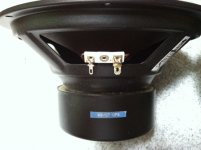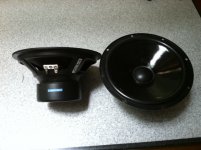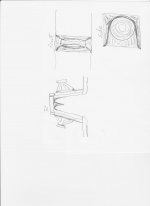So far, so right.You will agree that the volume of air displaced to the front and back
will have to be the same for practical purposes, the acoustic equivalent
of Kirchoff's law.
Acoustic energy is the product of volume displaced at a given pressure,
the acoustic equivalent of watts = volts X amps.
For a given signal, the pressure out the front is measurably higher ...
You will have to prove that, which you can't for 2 m and up for instance.... at any reasonable position or distance ... .
On the front you have concentrated the energy to a small slot. It has to expand into a half space of a given radius (2 m). To the back the same energy is distributed on a larger area - albeit with less pressure. This will need less expansion when filling the half space.If it is not sound, where did the energy go?
Show us a polar diagram from 2 m distance and this whole discussion will come to rest.When I said near field, I did not mean that I was sticking the microphone
in the slot - it is true that the farther away you get and as the frequency
goes lower the effect is diminished.
I think Sreten has a valid argument.
It may be that the two main protagonists are using different words to express similar science.
Now what if when the driver cone is "pushing" all that air out the slot, it is working "harder" in the push than it is in the pull where the open back has very light air loading? (imagine for a moment a bicycle tyre pump filled with water. One expels the water in a gushing jet. Which part of the two output energies from that total input energy imparted by the moving hand has more in it? The jet of water or the air rushing in to fill the void behind the pump piston?)
Could that senario require that the pushed air has more energy in it than the pulled air? Well why else would the cone be working harder? (very non scientific language !).
If there is more moving air energy in the slotted air, than in the open baffle (back face) air, then the total energy supplied by the amplifier is split unevenly between back and front.
This does not require extra efficiency from the driver.
Let's for simplicity assume that the three times smaller slot area gives three times the air velocity at the slot., cf. the rear air velocity. I'll choose not to address the ^2 or not ^2 properties of moving air.
So, is more energy being dissipated/heard at the front, than at the back?
That seems to be the question about which they are arguing.
Let's hear more.
It may be that the two main protagonists are using different words to express similar science.
Now what if when the driver cone is "pushing" all that air out the slot, it is working "harder" in the push than it is in the pull where the open back has very light air loading? (imagine for a moment a bicycle tyre pump filled with water. One expels the water in a gushing jet. Which part of the two output energies from that total input energy imparted by the moving hand has more in it? The jet of water or the air rushing in to fill the void behind the pump piston?)
Could that senario require that the pushed air has more energy in it than the pulled air? Well why else would the cone be working harder? (very non scientific language !).
If there is more moving air energy in the slotted air, than in the open baffle (back face) air, then the total energy supplied by the amplifier is split unevenly between back and front.
This does not require extra efficiency from the driver.
Let's for simplicity assume that the three times smaller slot area gives three times the air velocity at the slot., cf. the rear air velocity. I'll choose not to address the ^2 or not ^2 properties of moving air.
So, is more energy being dissipated/heard at the front, than at the back?
That seems to be the question about which they are arguing.
Let's hear more.
Last edited:
I'd say take it outside, measure it in the far field and you will see a dipole response at low frequency. +9dB on the front side in the near field is mostly due to the area of the slot compared to the area of the drivers. If the +9db remained in the far field, or even + 4.5dB, the response at low frequency would be that of a monopole. The Eq presented clearly shows gradient woofer behavior, and would not be appropriate. At higher frequency there will be a lack of symmetry between the front and rear due to the cavity resonances. Basically, at low frequency, in the far field, it won't perform much differently than a wide flat baffle with surface mounted woofers. Or, fold the side wings back and make it a W frame woofer.
[Edit]
At 2M you are not yet in the far field.
[Edit]
At 2M you are not yet in the far field.
Last edited:
Hello,
The only benefit of the slot is to have less panel shaking due to force cancellation.
Even order distortion could be partly attenuated if drivers are installed opposite phase. But, it may not produce better sounding speaker since taking out even order distortion leaves nasty sounding odd order which could become a dominant distortion product, depending on the drivers used.
- Elias
The only benefit of the slot is to have less panel shaking due to force cancellation.
Even order distortion could be partly attenuated if drivers are installed opposite phase. But, it may not produce better sounding speaker since taking out even order distortion leaves nasty sounding odd order which could become a dominant distortion product, depending on the drivers used.
- Elias
Given that the front to back SPL difference measurements are valid, what I can think of as an explanation is that the back has 6dB decline much sooner where the front has an extended baffle. That, plus 3dB planar wave front loss in the near field for the slot VS 6dB point source loss for the back array can add up to 9dB dif. as far as the slot's height and its floor image will define the near field frontal area. Beyond the transition to far field will lose 6dB if anechoic ending up 3dB dif front to back, or ~4.5dB in normal room due to reverberation reinforcement. There is strong EQ applied under baffle step as seen in the article's link, so those conditions extend to bass under 100Hz.
My main subwoofers are M-Dipoles with push-pull action and partly force cancelation.
I measured 2nd harmonic decrease of ca.10dB ( x 3 ). 2nd is by far the biggest distortion source in a speaker like that so i find it welcome even if the PROPORTION of 3rd is now higher. In my experiments i liked the push-pull combination better. Also sound wise.
I measured 2nd harmonic decrease of ca.10dB ( x 3 ). 2nd is by far the biggest distortion source in a speaker like that so i find it welcome even if the PROPORTION of 3rd is now higher. In my experiments i liked the push-pull combination better. Also sound wise.
Hi Salas,There can be cylindrical wave loss behavior in the near field from a tall slot thus preserving 3dB VS an point source across a distance and wavelength no further than d=1.5fhΛ2.
You are talking about a long slot,correct,but what about a focused slot one that won't have any parallel edges,and only a pair of facing speakers house,my Idea is that any cone motion will be felt or used at the front of the slot,maybe no reflection or canceling waves here?I have that some drawing problem Papa Nelson has I can't draw in cad,guess I need to learn how but if I could get those images out of my head on on paper I could show you! I'll take a shot at a hand drawing I can upload that!
Can someone tell me the flare rate per inch or do you think a few inches would matter as long as the slot opening is flared?
I have the deq2496 and the dcx2496 crossovers so I hope the RTA can give me some results,I will power them up first with some 350 watt gainclone and the try some other amps ,class D and some tubes and a F5(a simple build ! Thanks Nelson!) I have just built,That is if the neighbors don't come get me,lol.sometime they bring music and beer,other times like when I don't know what time it is BIG sticks,lol
Cheers!
So far, so right. You will have to prove that, which you can't for 2 m and up for instance.
I'm not hauling these heavy things outside, but since I have a large room,
I did the next best thing, which is to measure the bass response at 3 m,
(my listening position) and then simply turn the speaker around.
On average, the response is about 2.5 dB higher off the front. It's not the
4.5 dB I predicted, but it still demonstrates my point.
No Smoking:
It would be more of a resonant cavity with enhanced coupling to room's air due to flaring over a specific mid range bandwidth I guess. You will confirm by measurement. Slots enhance the horizontal dispersion over the vertical. I don't expect it to do anything in the bass.
It would be more of a resonant cavity with enhanced coupling to room's air due to flaring over a specific mid range bandwidth I guess. You will confirm by measurement. Slots enhance the horizontal dispersion over the vertical. I don't expect it to do anything in the bass.
On average, the response is about 2.5 dB higher off the front. It's not the
4.5 dB I predicted, but it still demonstrates my point.

You could go nearer prediction maybe if the slot was as tall as the room.
I've been trying to work this out in my head since sreten 1st stepped in. I'm still working it out.
At the speaker, the energy on each side is the same. After that no more energy is input. Speakers are notoriously inefficient because the driver acoustic impedance is mismatched with the air impedance and we have huge losses (circa 99%). If the slot reduces the losses (ie improves the transfer of energy from driver cone to the air) then we would see exactly the scenerio Nelson is observing.
It works in rear-loaded horns, where we have a similar situation, so we know it is possible.
dave
At the speaker, the energy on each side is the same. After that no more energy is input. Speakers are notoriously inefficient because the driver acoustic impedance is mismatched with the air impedance and we have huge losses (circa 99%). If the slot reduces the losses (ie improves the transfer of energy from driver cone to the air) then we would see exactly the scenerio Nelson is observing.
It works in rear-loaded horns, where we have a similar situation, so we know it is possible.
dave
You could go nearer prediction maybe if the slot was as tall as the room.
I think you might be right about that. At frequencies above 100 Hz, I see the
4-5 dB difference, but I hadn't considered that it might be a function of the
slot length.
Howdie,
Here is a rough sketch of one slot ,I have decided to build one like this ,test it and then build 2 cabinets with 6 of these slot unit 3 per cabinet,if I like the responce.
So about slot length do you think a larger area H x W would increase bass responce as oposed to eqing it there and by the same token make it smaller for midrange?
Is there a way to better couple a speaker to air ?
Cheers
Here is a rough sketch of one slot ,I have decided to build one like this ,test it and then build 2 cabinets with 6 of these slot unit 3 per cabinet,if I like the responce.
So about slot length do you think a larger area H x W would increase bass responce as oposed to eqing it there and by the same token make it smaller for midrange?
Is there a way to better couple a speaker to air ?
Cheers
Attachments
Sreten,
Are you a lawyer? You should be.
You can make an argument out of anything!
Hi,
No. I have a technical background, but you are wrong.
I will argue about anything that is simply a claim or conjecture,
and most annoyingly alleged "measured" evidence that makes
no technical or theoretical sense whatsoever.
I'm completely interested in what is the truth, unlike lawyers.
I don't argue for the sake of it, as quite frankly you can spout BS
until the cows come home, as some people do, it doesn't help.
I'm not participating in the technical arguments here anymore,
for the reasons I've previously stated, allegedly unrespectfull.
But what I suspected is happening, waffle over technical precision.
(I'm not interested in how it might be true, due to poor reasoning).
Forget me, get some of the serious dudes to agree, (we know
who they are), I''ll eat humble pie, meanwhile I'm not arguing.
rgds, sreten.
Serious Dudes - mainly left this site, I wonder why ?
Last edited:
Hi sreten,
No, this is not about technical stuff.
I remember some time ago, we had some 'discussins' in the T-bass circuit thread. At that time, I was one of the believers, you were the major doubter. Oh, let me rephrase, no, you didn't doubt, you were certain, very.
Theoretically, you could be right (under some conditions which I'm not so sure). In that topic, I and a few others built that circuit and enjoyed, while you were still holding that thought of "theoretical correctness".
Afterward, I dropped the T-bass circuit, but I didn't come to your camp. Instead, following the thinking of T-bass, I found an easier way to do similar thing which fit me even better. (maybe even more heretical to most people, but that's another story... )
You are definitely smarter than me, but I'm the one who enjoy these 'doubtful' things.
Now this slot loading OB. Guess what? Again, shortly after I read the thread, I started building it. Now it's almost done (one driver, horizontal version) ... ...
...
I'm no expert in the theoretical stuff, and probably stupidly believe in something in an overly optimistic enthusiasm. With only 'hope' of providing good thing to my system (and cost effective), I'd do it. Don't get me wrong, I'm not a gambler. I have my consideration (and instinct).
It's a matter of mindset. If we have to prove everything before we do it, we're going nowhere. In a foreseeable range, if there's more good than bad, I'd say it's good enough to try, at least in DIY audio. How harmful can it be? For me, only the cost of a sheet of (low grade) plywood, and several hours of woodworking. And I'll be perfectly fine if it doesn't give me 9 more dB at the front, too. How bad can it be? Worse than my suspended nude woofers?
Pity you can't have the pleasure.
edit. If technical perfection is that important, than class D and single ended triode amp shouldn't exist. Neither do cone/dome speakers, stereo sound, and so many othres...
No, this is not about technical stuff.
I remember some time ago, we had some 'discussins' in the T-bass circuit thread. At that time, I was one of the believers, you were the major doubter. Oh, let me rephrase, no, you didn't doubt, you were certain, very.
Theoretically, you could be right (under some conditions which I'm not so sure). In that topic, I and a few others built that circuit and enjoyed, while you were still holding that thought of "theoretical correctness".
Afterward, I dropped the T-bass circuit, but I didn't come to your camp. Instead, following the thinking of T-bass, I found an easier way to do similar thing which fit me even better. (maybe even more heretical to most people, but that's another story... )
You are definitely smarter than me, but I'm the one who enjoy these 'doubtful' things.
Now this slot loading OB. Guess what? Again, shortly after I read the thread, I started building it. Now it's almost done (one driver, horizontal version) ...
I'm no expert in the theoretical stuff, and probably stupidly believe in something in an overly optimistic enthusiasm. With only 'hope' of providing good thing to my system (and cost effective), I'd do it. Don't get me wrong, I'm not a gambler. I have my consideration (and instinct).
It's a matter of mindset. If we have to prove everything before we do it, we're going nowhere. In a foreseeable range, if there's more good than bad, I'd say it's good enough to try, at least in DIY audio. How harmful can it be? For me, only the cost of a sheet of (low grade) plywood, and several hours of woodworking. And I'll be perfectly fine if it doesn't give me 9 more dB at the front, too. How bad can it be? Worse than my suspended nude woofers?
Pity you can't have the pleasure.
edit. If technical perfection is that important, than class D and single ended triode amp shouldn't exist. Neither do cone/dome speakers, stereo sound, and so many othres...
Last edited:
- Status
- This old topic is closed. If you want to reopen this topic, contact a moderator using the "Report Post" button.
- Home
- Loudspeakers
- Multi-Way
- Nelson Pass: The Slot Loaded Open Baffle Project


